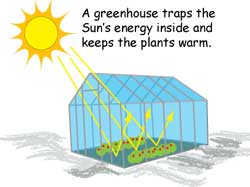 A greenhouse is for growing plants. It is made of glass or clear plastic to let in lots of sunlight. But why not just put the plants outside? A greenhouse stays warmer than the air outside. Instead of cooling off at night, it traps some of the heat inside to keep the plants warm. Even in the winter, with no heat source but the Sun on a clear day, a greenhouse stays warmer than the air outside. In the summer, if a greenhouse gets too hot, the gardener can open the windows and doors and maybe turn on a fan.
A greenhouse is for growing plants. It is made of glass or clear plastic to let in lots of sunlight. But why not just put the plants outside? A greenhouse stays warmer than the air outside. Instead of cooling off at night, it traps some of the heat inside to keep the plants warm. Even in the winter, with no heat source but the Sun on a clear day, a greenhouse stays warmer than the air outside. In the summer, if a greenhouse gets too hot, the gardener can open the windows and doors and maybe turn on a fan.
Greenhouse Earth?
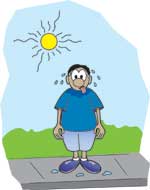 A greenhouse is terrific if all you want to do is grow heat-loving plants. But what if Earth's atmosphere started to behave like a too-hot greenhouse? Don't forget, we cannot open Earth's windows or doors to cool it off. Earth as a closed-up greenhouse would soon grow to be ghastly!
A greenhouse is terrific if all you want to do is grow heat-loving plants. But what if Earth's atmosphere started to behave like a too-hot greenhouse? Don't forget, we cannot open Earth's windows or doors to cool it off. Earth as a closed-up greenhouse would soon grow to be ghastly!
If you made our Gummy Greenhouse Gas models, you may wonder why the molecules you made with gumdrops are called greenhouse gases. Here is why: If the atmosphere contains too much of these gases, the whole Earth becomes a hotter and hotter greenhouse. The atmosphere holds onto too much of the heat at night instead of letting it escape into space. Then, the next day, the Sun heats Earth's surface even more.
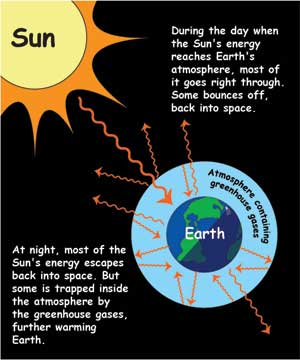
If the atmosphere works too well as a greenhouse, each day gets a little warmer and a little warmer. We may not be able to measure this effect from day to day or even year to year. But over tens of years, a few degrees of warming starts causing changes. For example, ice melts in the North and South Pole regions. All this new liquid water raises the sea level. Cities built on coastlines could someday be under water!
When the oceans get warmer, weather is affected everywhere. Some places have more severe storms and other places have hardly any rain at all. And many other changes could occur that would be bad for humans and other living things.
Our burning desires
Some of the greenhouse gases in the atmosphere are caused by humans. Whenever we burn anything, such as—
gasoline in our cars and trucks,
jet fuel in our planes,
coal in our factories or powerplants,
trees to clear the land for farming
—we pollute our atmosphere with carbon dioxide and carbon monoxide. Although carbon monoxide does not act as a greenhouse gas, it is poisonous to breathe.
|
Gumdrop model of a carbon dioxide molecule, CO2 . It has one carbon atom and two oxygen atoms all bonded together. |
Gumdrop model of a carbon monoxide molecule, CO. It has one carbon atom and one oxygen atom bonded together. |
Our livestock (cows, pigs, and chickens, for example) also pollute the atmosphere with methane from their digestion process.
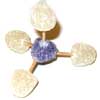
Gumdrop model of a methane molecule, CH4. It has one carbon atom and four hydrogen atoms all bonded together.
Ozone is made when the Sun cooks carbon monoxide, such as from our car and truck exhaust, with other chemicals in the atmosphere.

Gumdrop model of ozone molecule, O3 . It has three oxygen atoms bonded together.
Good ozone, bad ozone
In the case of ozone, it's all about location, location, location.
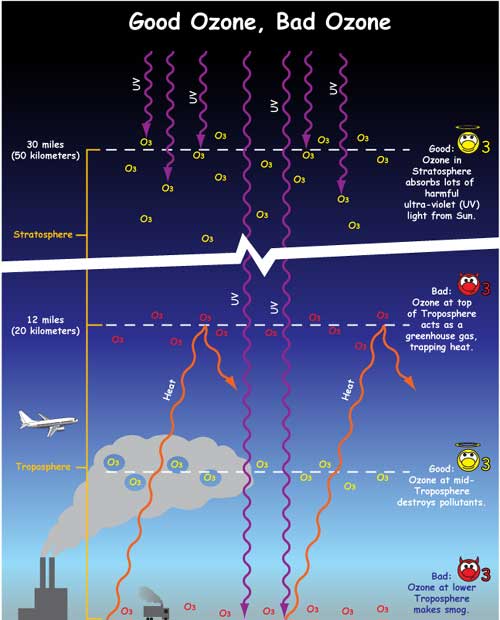
Drawing shows four different levels of ozone in the atmosphere. At top of stratosphere, 30 miles high, ozone absorbs most of the harmful ultraviolet radiation from the Sun. At the top of the troposphere, 12 miles high, ozone acts as a greenhouse gas, trapping heat. In the middle of the tropsohere, ozone helps clean up certain pollutants. At the bottom of the troposphere, at Earth's surface, ozone makes smog.
Scientists have divided the atmosphere into different layers, each with a name. The layer closest to the ground, where we live and fly in jets, is called the troposphere [TRO-po-sphere]. Above that layer is the stratosphere [STRAT-o-sphere], which goes to about 30 miles high. (Three more layers above that have names too, but we won't talk about those right now.)
 Ultraviolet radiation from the Sun causes sunburns and skin cancer. Ozone high in the stratosphere shields us from much of this ultraviolet radiation.
Ultraviolet radiation from the Sun causes sunburns and skin cancer. Ozone high in the stratosphere shields us from much of this ultraviolet radiation.
That's good.
 But at the top of the troposphere, ozone acts as a greenhouse gas and adds to global warming.
But at the top of the troposphere, ozone acts as a greenhouse gas and adds to global warming.
That's bad.
![]() In the middle region of the troposphere, ozone helps to clean the atmosphere of certain pollutants.
In the middle region of the troposphere, ozone helps to clean the atmosphere of certain pollutants.
That's good.
![]() But in the atmosphere close to Earth's surface where we live, ozone adds to smog and is hard on plants and animals, including us.
But in the atmosphere close to Earth's surface where we live, ozone adds to smog and is hard on plants and animals, including us.
That's bad.






